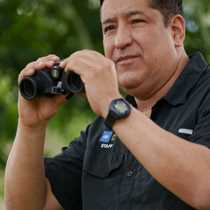Genovesa Island
Early in the morning, just at the moment the sun was rising in the horizon, we arrived to Genovesa Island. The National Geographic Endeavour was received by many juvenile red footed boobies and some few frigates that flew along and over the ship. This welcoming committee was a good premonition for what this day would be – one of the best in this week’s expedition around the Galapagos archipelago.
Genovesa Island, located up in the northernmost part of the archipelago and quite distant from any of the central islands, is extremely interesting for its isolation has been the key for attracting so many sea birds. The biggest colony of red footed boobies in the Galapagos Islands is found here. This latter species is one of the most colorful ones in the Galapagos. Blue, lila, pink and bright red colors contrasting with the tan plumage made this combination an exquisite one to be seen in a bird!
In this small but beautiful Island, because of its fragility, the Galapagos National Park requires that the guests should be divided in two big groups in order to visit the island. Half of the visitors must go to Darwin’s Bay area and the other half must visit the Prince Phillips’ steps. In the afternoon we switch places. In this way, all visitors will see the only two locations on the island minimizing our impact in this paradisiacal island.
Darwin’s Bay is, in a nutshell, magical! Just after landing on the island we started to listen to the many sounds that fill the air. Juvenile boobies were asking for a meal from their parents, above us frigates were seen flying patrolling the area, searching for some naïve red footed booby to harass. The intention of the frigates is to obligate the boobies to regurgitate their meal, stealing it in midair after all of that! Several swallow tailed gulls with their young chicks were seen sitting on the lava rocks or on the beach. All of these birds against an idyllical background made a very impressive scene that made many of us think of a Garden of Eden filled with fearless creatures. As the walk progressed the sun came out and somehow it gets a little hot. It was just on time as the next activities planned for the day were snorkeling and kayaking. Snorkeling was spectacular, for many it was the first time to meet a shark and/or rays in the water.
On the walk in Prince Phillips’ steps we walked right next to many frigate birds. There were many juveniles everywhere. Near the end of the walk we saw a Short -eared owl on the lava fields, the perfect ending for such a fantastic hike.
The images of today, together with all the array of feelings and memories that we have compiled along the week, will hopefully remain in our hearts and minds for the rest of our lives.




